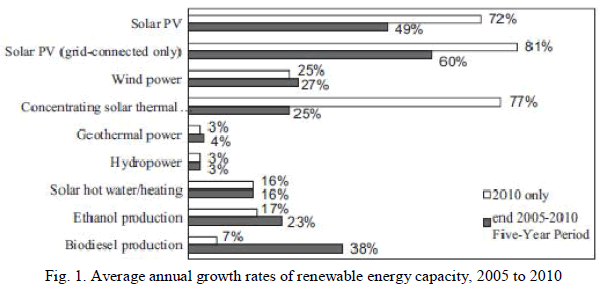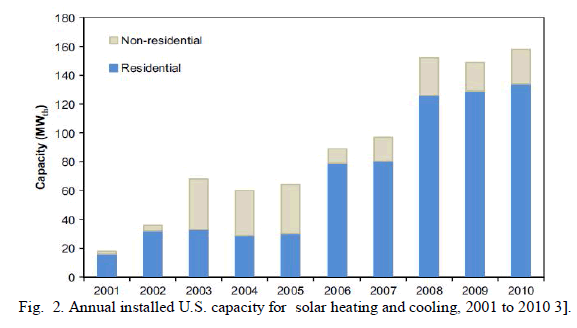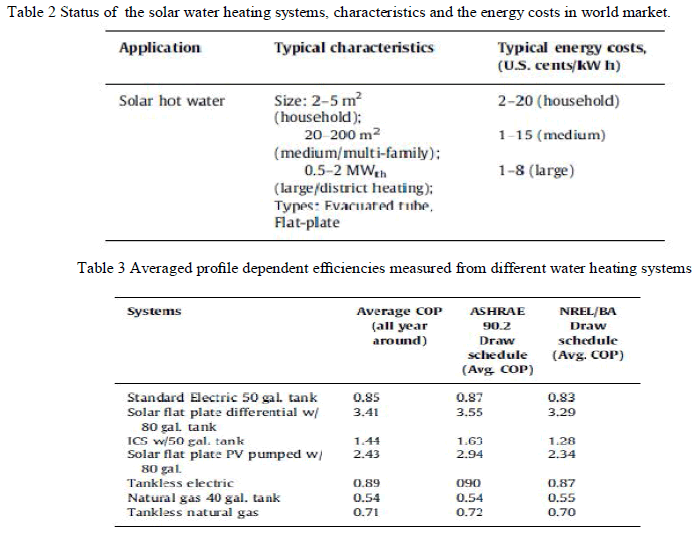ISSN ONLINE(2319-8753)PRINT(2347-6710)
ISSN ONLINE(2319-8753)PRINT(2347-6710)
Seema .S. Billur1, Vaijanath V. Yerigeri2, Ravi V. Yerigeri3
|
| Related article at Pubmed, Scholar Google |
Visit for more related articles at International Journal of Innovative Research in Science, Engineering and Technology
One of the most widely known solar thermal applications is solar water heating. In terms of installation expenditures and energy cost over the total life of the system, solar water heating technology has proven to be cost efficient for several domestic and industrial applications. Technological practicability of these systems has long been recognized and is presently employed in commercial sectors of many countries. This paper presents an overview of various types of solar assisted water heating systems and their market potential. Residential solar water heating is a promising age old technology, which has been evolved and developed both in the range and quality as a successful packaged market–product. The first part of this paper analyzes the performances along with how unique they are of different types of solar water heating systems and the later part of the paper covers its economic aspects.
Keywords |
| Energy, survey solar power, Water heating |
INTRODUCTION |
| Renewable energy sources have the capacity to play a significant role in replacing conventional fuels in four distinct zones, such as electric power production, hot water production, transportation of fuels, and countryside (off-grid) power services. Fig. 1 represents the average annual growth in various renewable energy sectors, and by 2010 over 100 countries had initiated policy targets or promotion incentives related to renewable energy. Since 1980 the use of solar technology has increased at a rate of about 30% yearly [1]. In 2010, Renewable Energy Policy Network has reported that about 70 million houses are now using solar water heating (SWH) systems worldwide. The economic benefits of the utilization of SWH can mainly be realized through savings in fuel costs for water heating and environmental issues. SWH systems are becoming widespread and are now contributing significantly to both domestic and industrial sectors in several countries. China currently dominates the global solar thermal market. |
| Chinese companies manufactured 28 million square meters of system in 2009 which was above 80% of global solar hot water/heating output. Apart from China, Germany, Turkey, Brazil, and India lead the solar hot water market. The European Union (EU) utilizes most portion of the remaining total installed SWH capacity. Germany marked a record in 2008 with an estimated SWH capacity of about1.1 GW, but the new installations were slightly lower in 2009. Similarly, the government of Brazil targeted a reduction of more than 1000 MW additional energy installations by the year 2015 through the initiation of SWH systems. On an average, about 20,000 SWH systems are being installed each year in India. On the other hand, the US domestic market capacity is still relatively small compared to the rest of the world but it is increasing. SWH market is also expanding in the countries of Africa, such as Ethiopia, Kenya, South Africa, Tunisia, and Zimbabwe. Palestine has the highest installation capacity among the countries of Middle Eastern and North African region. The capacity accounted for 68% of all the households that installed SWHs routinely in new buildings in that region. |
| As discussed above, although SWH systems have a huge prospectus, only a fraction of the projected possible utilization has been realized . Fig. 2 shows the overall percentage of the World’s installed SWH system in different regions. In 2010, the total installed capacity of SWH systems and space heating systems increased by an estimated 16%, reaching only about 185 GW of thermal energy globally (Table 1). As projected, the energy requirement by the year 2030 at about 0.6% more land will be required for 10% net efficient solar conversion systems. In general, SWH technology is considered to be a matured one that has attained commercialization. Yet, there exists several opportunities to further improve the system performance for an increase in its reliability. |
 |
 |
 |
| Renewable energy research has become increasingly important since the signing of the Kyoto Protocol, and more work is being carried out in analyzing different aspects of SWH systems, such as collector design, storage tank, and different working fluids, to suit regional or specific geographical conditions. There exists distinct advantages and scope for SWH systems, and hence a detailed study on the performance of various types of SWH devices, including cost effectiveness and related economical factors of such systems are presented in this paper. |
RELATED WORK |
| In SWH advanced from hypothesis to a prototype in the year 1767 by Swiss naturalist De Saussure, who built an insulated box painted black at its bottom with two panes of glass covering at the top [6]. He called it ‘‘Hot Box’’, as the invention was capable of aiding in cooking, heating, and producing hot water. But the first commercial SWH, named Climax, was patented in the US by Clarence M. Kemp in 1891. His idea was further implemented as an integral collector storage solar water heater. Kemp placed a metal tank within a wooden box covered by a glass cover at the top part. His system produced hot water (38.8 1C) on sunny days. As an alternate to burning wood or expensive fuel for heating water, the SWH became popular in California and many other states very quickly. A third of all of the homes in Pasadena, California had SWH systems by 1897 [8]. In early 1900s, several researchers focused their attention in improving the design of the SWH system to make it durable and efficient. In 1909, William Bailey tailored the Kemp’s SWH system, by segregating it into two major parts; the solar thermal collector for collecting solar radiation along with storage tank for storing the produced hot water. Further, to prevent heat losses the storage tank was insulated. For the first time in the SWH field, William Bailey introduced the thermosyphon principle to aid the circulation of water in the collector and storage tank. In 1950, Japan’s first commercial SWH was designed by Yamamoto by getting an inspiration from a view of a large bath tub, filled with water that was kept outside in the sunshine for a longer period of time. Later, SWH units based on the closed-pipe system were introduced. |
| Solar heated water was utilized for several applications. Until 1930, hot water for domestic purposes and for space heating were mainly engaged by the coal fired boilers. SWH become a commercial product in the early 1960s. A typical SWH is of a thermosyphon kind that uses an absorber area of 3–4 m2 flat-plate type solar collectors to energize a capacity of 150–180 l storage tank. One of the popular types of SWH systems is the forced circulation water heating system. Except for solar collectors, other accessory items such as the storage tank incorporated with piping, pump, and differential thermostat are usually kept indoors. |
| Solar assisted systems not only rely on the conventional mode of utilizing energy but also other systems, such as heat pump (HP) and photovoltaic thermal (PV/T). In 1927, HP technology was first patented by an English inventor T. G. N. Haldane. However, before the 1960s, due to a record poor reliability of the HP units, the commercial distribution was very limited. Since then, research focus was directed on, and by the year 1970, the HP technology has been improved in quality and reliability. Moreover, the researchers had been motivated to find new alternative energy sources for energy production since the big oil crisis in 1973. This further aided the application of HP technology and it became widespread for both heating and cooling purposes. Although solar HP technology has shown higher efficiencies (400–600%) in respective functions, its capital cost is high, and hence it may not be suitable in places where cost of the system becomes a constraint. |
| Table 2). The production of SWH is now in packaged form and developed into a considerable business in the 21st Century. In countries such as China, Australia, Germany, Greece, Israel, and USA, the manufacturing of SWHs has become a part of the industrial sector. Self-motivation is a factor that worked behind the rapid expansion of SWH manufacturing industries in most parts of Europe. Currently, commercially available SWHs employ the following types as the packaged form: a system being operated by passive mode with an anti-freeze working fluid, solar-assisted heat pump system, a variety of evacuated solar collectors of both flat- plate and tubular in shape, and an active circulation system driven by pumps facilitating a wide range of flow rates. |
INSTALLED MARKET STRUCTURE AND RELATED COSTS OF SWH SYSTEMS |
| Solar thermal collectors are mainly used for heating water to provide heating or cooling depending on the domestic and industrial sectors’ requirement. It has been estimated by solar energy industries association (SEIA) and Green Technology Media that SWH installation has increased by 6% in 2010 relative to the previous year solar market in US . Fig. 22 shows the shipment details of solar collectors in US from the year 2001 to 2010. Among the residential installations, pool heating by utilizing solar thermal collectors has increased 13% in US. Approximately 81% of medium- temperature collectors for the year 2008 were used for water heating. The increase in shipment of medium-temperature collectors over last decade is supposed mostly due to the Federal tax credits and state incentives. In 2010, California Solar Initiative adopted new program to increase the number of SWH installations by adopting state rebates. Though this initiative, a customer can reduce the associated capital cost of a typical residential SWH ranging from $2000 to $3000 up to 30% by taking advantages of the initiatives. A global characteristic status of SWH systems and related energy costs are listed in Table 5 for reference. |
| Morrison and Wood had surveyed and presented a detailed 20 year-progress report which includes various SWH designs on current market trend. The primary exporters of SWHs are Australia, Greece, and USA; most other countries only supply domestic demand. Solar water heaters have two main merits, such as reducing the impact on environment pollution and serving as an alternative replacement to the conventional fuel. Wood and He [135] have illustrated a life-cycle-cost model to evaluate the total cost and benefits of ownership. Both, the power generation technologies, and SWH service life of each component were taken into account. The California Energy Commission had created a comprehensive economic model for SWH devices in collaboration with the solar industry. Based on a conservative life- time of 10 years, the annual cost for heating water using solar collector ranges between $514 and $527, depending on the energy factor (ratio of useful energy to the energy consumption). The cost of the SWH system also varies depending on the location, hot water load, and utility costs. For low capacity heating, such as pool heating, the installation cost varies from $100 to $2400 per square meter of collector area. However, installation costs for the glazed SWH systems vary from $640 to $1600 per square meter of solar collector area [137]. According to National Institute of Building Science, an installed SWH system against electricity can reduce the water heating bills up to 80%. Based on the life- cycle analysis, the energy independence and security act (2007) estimated the life-cycle of a SWH system is about 40 years. |
 |
 |
| Florida Solar Energy Center carried out a performance testing on seven types of water heating systems which utilized either solar energy, or commercial energy sources, such as electricity or natural gas. A comprehensive report was published in the 2010 and the results are summarized in Table 3. The reported results indicate that solar flat-plate water heating system of an 80 gallon capacity consumed the lowest daily average energy consumption and performed well with a reasonably higher COP compared to other water heating systems. |
CONCLUSIONS |
| This review paper primarily discussed the design features and related technical advancements of the SWH systems in terms of energy efficiency and cost effectiveness. One of the widely acknowledge- edged benefits of the SWH systems is in the potential of energy savings. Therefore, the economic evaluation and the life cycle analysis are a necessary assessment to determine the feasibility of such systems. All of the economic evaluation factors that affect the SWH systems are also discussed in this review to find the specific energy efficient approaches depending on the size and particular energy demands. Using all of the discussed factors of this review, the actual penetration of the SWH systems in any demographic area can be assessed. This accurate economic potential assessment is necessary to increase the number of SWH consumers. Although few countries/places are more concerned in promoting SWH systems by overcoming all of the technical and economical barriers, it is not been equally promoted in the rest of the world because of several economical and technical issues. In this study it was observed that the installation of SWH systems are more feasible on a large area compared to small unit wise installation per households in terms of energy conservation and per unit energy cost over initial costs. In many large scale applications, such as commercial building sectors, both economical and technological feasibility assessment can con- tribute in the reduction of energy cost. In the case of packaged SWH units, currently many small enterprises are in the manufacturing stages worldwide. However, the cost and quality of the products are still not in the satisfactory level. More government rebates and benefits could help the small scale manufacturers to flourish more of the SWH systems from large to small-scale, stricter quality control rules should be imposed, so that it can compete with the conventional water heating systems. |
References |
|